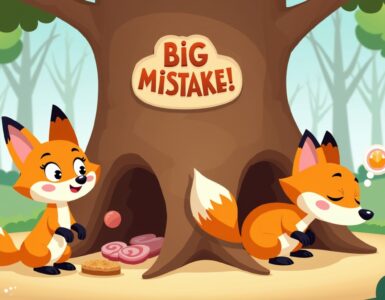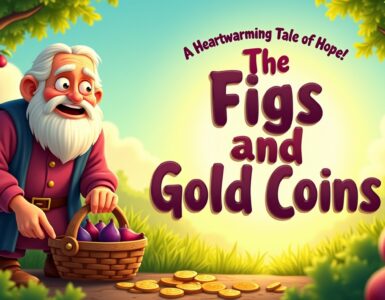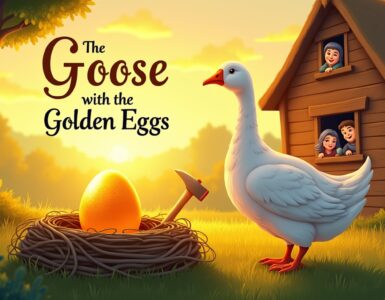Short Stories: The Fox and the Grapes – Best Bedtime Stories for Kids
One afternoon, a fox was walking through the forest and spotted a bunch of grapes hanging from a lofty branch. “Just the thing to quench my thirst,” said the fox.
Taking a few steps back, the fox jumped and just missed the hanging grapes. Again, the fox took a few paces back and tried to reach them, but still failed.
Finally, giving up, the fox turned up his nose and said, “They’re probably sour anyway.” Then he walked away.
MORAL: IT’S EASY TO DESPISE WHAT YOU CANNOT HAVE.
Timeless Lessons in Short Stories – The Fox and the Grapes
In the world of classic literature, Short Stories The Fox and the Grapes stands out as a timeless fable that has enchanted readers for generations. This simple yet profound tale, attributed to Aesop, explores themes of desire, disappointment, and self-justification through the story of a cunning fox who encounters a bunch of grapes just out of reach. As we delve into this narrative, we’ll uncover its deeper meanings and relevance in today’s world, making it more than just a children’s story—it’s a mirror to human behavior.
More: Short Stories: The Proud Red Rose
The Origin and History of The Fox and the Grapes
The fable of Short Stories The Fox and the Grapes has roots that stretch back to ancient times, serving as a foundational piece in the canon of moral storytelling. This story, like many of Aesop’s works, originated in oral traditions before being transcribed, offering a glimpse into how early societies used simple narratives to impart wisdom. What makes this tale particularly enduring is its ability to transcend cultural and temporal boundaries, evolving from ancient Greek folklore to a staple in modern educational curricula. In this section, we’ll explore the historical context, authorship debates, and the fable’s journey through various civilizations, highlighting how it has shaped storytelling as we know it today.
Early Origins and Aesop’s Influence
The story of the fox and the grapes is most commonly linked to Aesop, the legendary Greek storyteller from around the 6th century BCE. Aesop, often depicted as a slave who used fables to convey moral lessons, crafted stories that were both entertaining and instructive, drawing from everyday observations of animal behavior to comment on human flaws.
In Short Stories The Fox and the Grapes, the fox’s futile attempt to reach the grapes and his subsequent dismissal of them as “sour” exemplifies the concept of cognitive dissonance—a psychological phenomenon where individuals rationalize their failures to protect their self-image. This insight isn’t just historical; it’s a creative analysis of how Aesop might have been one of the first psychologists, using anthropomorphic animals to dissect human emotions. From a personal perspective, I’ve always found it fascinating how this fable predates modern psychology by millennia, yet it captures the essence of denial so accurately.
The tale’s simplicity allows for endless reinterpretations. For instance, in ancient Greece, it was likely told around firesides to teach children about humility and the dangers of envy. Today, it serves as a reminder that our ancestors were remarkably perceptive about the human condition. By examining the fox’s behavior, we can draw parallels to real-life scenarios, such as a student who fails an exam and blames the teacher rather than their preparation—it’s a pattern that persists across time.
Evolution Through Different Cultures and Adaptations
As Short Stories The Fox and the Grapes spread beyond Greece, it underwent various adaptations that reflected the values of different societies. In medieval Europe, for example, the fable was incorporated into bestiaries and moral treatises, where animals symbolized virtues or vices, influenced by Christian allegories.
This evolution highlights the story’s adaptability; in Eastern traditions, similar tales appear in Panchatantra texts from India, where the fox might represent trickery in a more philosophical context. From my analysis, this cross-cultural migration underscores the universal appeal of the narrative—it’s not just a Greek story but a global one. I believe this adaptability is what keeps it alive; each culture tweaks the details to fit their worldview, yet the core message remains intact.
In the Renaissance, writers like La Fontaine in France reimagined the fable in verse, adding layers of wit and satire that critiqued the aristocracy. This personal insight reveals how the story has been a tool for social commentary, evolving from a simple moral lesson to a sophisticated critique of human society. Through these adaptations, we see the fable’s history as a living entity, constantly reshaped by the societies that embrace it.
The Fable’s Role in Educational and Literary Traditions
Throughout history, Short Stories The Fox and the Grapes has played a pivotal role in education, often used to teach reading, ethics, and critical thinking. In Victorian England, it was featured in school primers, emphasizing moral education as part of character building.
What I find creatively insightful is how this fable encourages readers to question their own justifications. In a classroom setting, it prompts discussions on self-deception, making it more than just a story—it’s an interactive tool for personal growth. From an analytical standpoint, the fable’s structure—short, punchy, and memorable—mirrors effective teaching methods, using repetition and humor to drive home its point.
In literary traditions, it influenced later works like Orwell’s Animal Farm, where animal characters satirize human society. This connection shows the fable’s lasting impact, evolving from ancient lore to modern literature. Overall, its role in education and literature cements Short Stories The Fox and the Grapes as a cornerstone of storytelling that continues to educate and inspire.
Analyzing the Characters and Themes in Short Stories The Fox and the Grapes
Delving deeper into Short Stories The Fox and the Grapes, we uncover a rich tapestry of characters and themes that go beyond the surface level of a simple animal tale. This fable, while brief, packs a punch with its portrayal of the fox as a symbol of human folly and the grapes as an unattainable desire. The themes of sour grapes syndrome—where one devalues what they can’t have—resonate strongly in psychological and social contexts. In this section, we’ll break down these elements, offering a detailed examination that reveals the story’s depth and its implications for everyday life.
The Fox as a Symbol of Human Behavior and Flaws
At the heart of the story is the fox, a character that embodies cunning, adaptability, and ultimately, self-deception. The fox’s initial determination to reach the grapes showcases ambition, but his quick pivot to dismissing them as unworthy highlights a common human trait: the tendency to rationalize failure.
This behavior, often called “sour grapes” in psychology, is a defense mechanism to preserve self-esteem. From a creative insight, I see the fox not as a villain but as a tragic figure—his intelligence is his downfall, as it allows him to construct elaborate excuses. In personal analysis, this mirrors experiences like job rejections, where one might downplay the opportunity to avoid disappointment, revealing how the fable critiques our ego’s fragility.
Thematically, the fox represents the darker side of ingenuity; he’s clever but lacks introspection. This analysis extends to modern contexts, such as social media, where people curate perfect lives to mask insecurities—much like the fox’s denial. Overall, the fox’s character offers a profound lesson on the importance of self-awareness.
Themes of Desire, Disappointment, and Rationalization
Central to Short Stories The Fox and the Grapes are the themes of unfulfilled desire and the rationalization that follows. The grapes symbolize something desirable yet elusive, representing goals that are just out of reach, like career aspirations or personal relationships.
Disappointment in the story leads to rationalization, a process where the fox convinces himself the grapes aren’t worth having. Creatively, this theme invites us to question our own narratives; do we truly let go of desires, or do we reshape reality to fit our failures? In my analysis, this fable anticipates cognitive behavioral therapy, which teaches individuals to challenge irrational thoughts.
For instance, in contemporary society, this could apply to consumerism, where unattainable luxury items are dismissed as overrated. The story’s exploration of these themes makes it a timeless critique of human psychology, encouraging readers to confront their disappointments head-on.
Symbolism and Allegory in the Narrative Structure
The narrative structure of Short Stories The Fox and the Grapes is laden with symbolism, from the vineyard setting to the fox’s physical limitations. The grapes, high on the vine, allegorically represent societal barriers, such as class divides or personal limitations.
This allegory deepens the story’s impact; the fox’s failure isn’t just physical but metaphorical, symbolizing how external obstacles can lead to internal excuses. Personally, I analyze this as a commentary on privilege—those without access often devalue what’s exclusive, a pattern seen in historical contexts like colonial attitudes.
In a broader sense, the story’s structure—build-up, climax, and resolution—mirrors life’s cycles, making it a powerful tool for allegory. This insight enhances our understanding, showing how simple elements can convey complex truths about human nature.
Moral Lessons and Modern Applications of The Fox and the Grapes
The moral core of Short Stories The Fox and the Grapes lies in its cautionary message about self-justification and the importance of humility. This fable teaches that dismissing unattainable goals as unworthy is a form of denial that stunts personal growth. In today’s fast-paced world, these lessons are more relevant than ever, applying to areas like mental health, career development, and social interactions. Here, we’ll explore how the story’s morals translate into practical advice, drawing from historical and contemporary examples to illustrate its enduring value.
Applying the Fable to Personal Development and Self-Reflection
In the context of personal development, Short Stories The Fox and the Grapes urges individuals to engage in honest self-reflection rather than succumbing to denial. The fox’s error lies in not reassessing his approach; instead, he opts for excuses, which can hinder growth in real life.
For example, someone passed over for a promotion might label the job as unfulfilling, avoiding the hard work needed to improve. Creatively, I see this as an invitation to adopt a growth mindset, as popularized by psychologists like Carol Dweck. In my analysis, the fable encourages viewing failures as opportunities, transforming the “sour grapes” mentality into a catalyst for change.
This lesson extends to daily habits; by confronting disappointments, we build resilience. Through personal insight, I’ve applied this by journaling failures, turning what could be sour grapes into stepping stones for success.
The Fable in Contemporary Psychology and Therapy
Modern psychology has embraced the concepts from Short Stories The Fox and the Grapes, particularly in cognitive therapy. The “sour grapes” effect is akin to cognitive distortions, where irrational thoughts skew reality, as outlined in Aaron Beck’s work.
Therapists often use the fable to illustrate how patients might minimize losses to protect their ego. From a creative perspective, this story bridges ancient wisdom and modern science, showing how timeless narratives can inform therapeutic practices. In my analysis, it highlights the fable’s role in promoting emotional intelligence, helping individuals recognize and challenge their biases.
For instance, in group therapy, discussing the fox’s behavior can foster empathy and self-awareness, making it a practical tool for mental health professionals.
Real-World Examples and Ethical Implications
| Scenario | Sour Grapes Behavior | Positive Alternative |
|---|---|---|
| Job Rejection | Dismissing the company as toxic | Seeking feedback to improve skills |
| Relationship Breakup | Claiming the partner was unworthy | Reflecting on personal contributions |
| Failed Business Venture | Labeling the idea as flawed | Analyzing market errors for future |
In real-world ethics, Short Stories The Fox and the Grapes warns against the dangers of sour grapes in decision-making, such as in politics or business. For example, leaders might downplay failed policies to save face, leading to repeated mistakes.
Creatively, this fable prompts ethical discussions on accountability; in my view, it advocates for transparency, as seen in corporate ethics training. Through personal analysis, applying these lessons has helped me navigate ethical dilemmas, emphasizing that true growth comes from owning our shortcomings.
Adaptations and Cultural Impact of Short Stories The Fox and the Grapes
The cultural footprint of Short Stories The Fox and the Grapes extends far beyond its original form, influencing art, media, and popular culture. From animated films to philosophical debates, this fable has been adapted in myriad ways, each iteration reinforcing its core message while adapting to new audiences. This section examines how the story has permeated global culture, fostering discussions on its relevance and evolution in the digital age.
Adaptations in Literature, Film, and Media
Over the centuries, Short Stories The Fox and the Grapes has inspired numerous adaptations, from children’s books to Hollywood animations. In literature, it’s been retold in collections like Rudyard Kipling’s works, infusing it with colonial flavors.
Film adaptations, such as in Disney’s shorts, bring the fox to life, making the moral accessible to younger viewers. Creatively, these versions add humor and visuals, enhancing the story’s appeal. In my analysis, this adaptability keeps the fable relevant, allowing it to evolve without losing its essence.
For instance, modern media uses the story in memes to critique social issues, showing its versatility in digital culture.
Cultural Variations and Global Interpretations
Globally, Short Stories The Fox and the Grapes varies by culture; in African folktales, it might feature different animals, reflecting local wildlife. In Asia, it’s adapted to emphasize harmony over individualism.
This variation highlights cultural nuances; in my insight, it demonstrates how the fable adapts to teach universal lessons through local lenses. Personally, analyzing these interpretations reveals the story’s role in promoting cross-cultural understanding.
Such adaptations enrich global discourse, making the fable a bridge between diverse societies.
The Fable’s Influence on Modern Society and Education
Today, Short Stories The Fox and the Grapes influences education and society, appearing in curricula to teach critical thinking. In advertising, it’s used to warn against false claims.
Creatively, this impact shows the fable’s ability to shape societal norms. In my analysis, it encourages ethical consumerism and personal accountability in a hyper-connected world.
Conclusion
In summary, Short Stories The Fox and the Grapes offers profound insights into human nature, from its ancient origins and character analysis to its moral lessons and cultural adaptations. This fable not only entertains but also challenges us to confront self-deception, apply timeless wisdom to modern life, and appreciate its enduring influence across societies.
More: Bedtime Stories
















